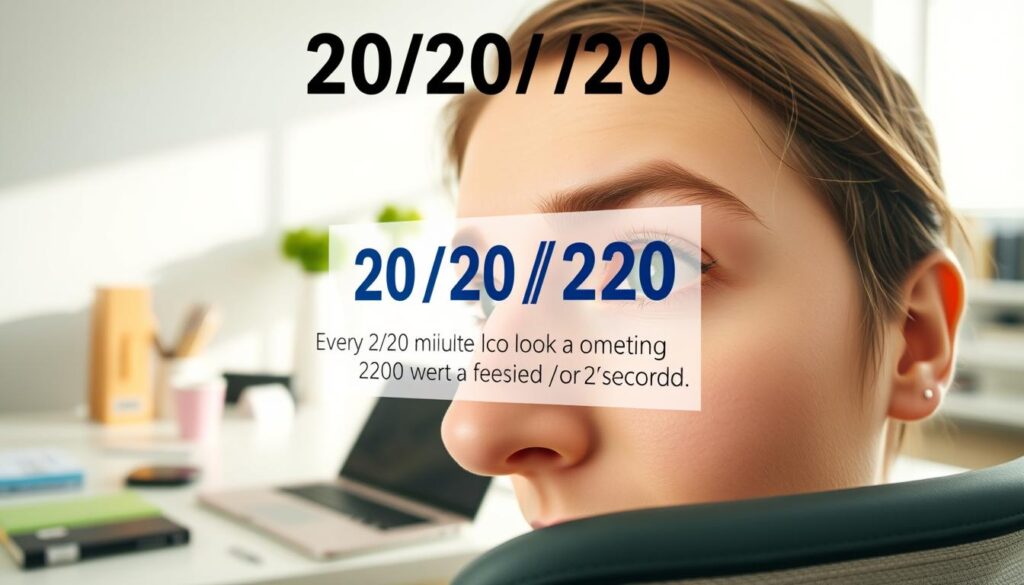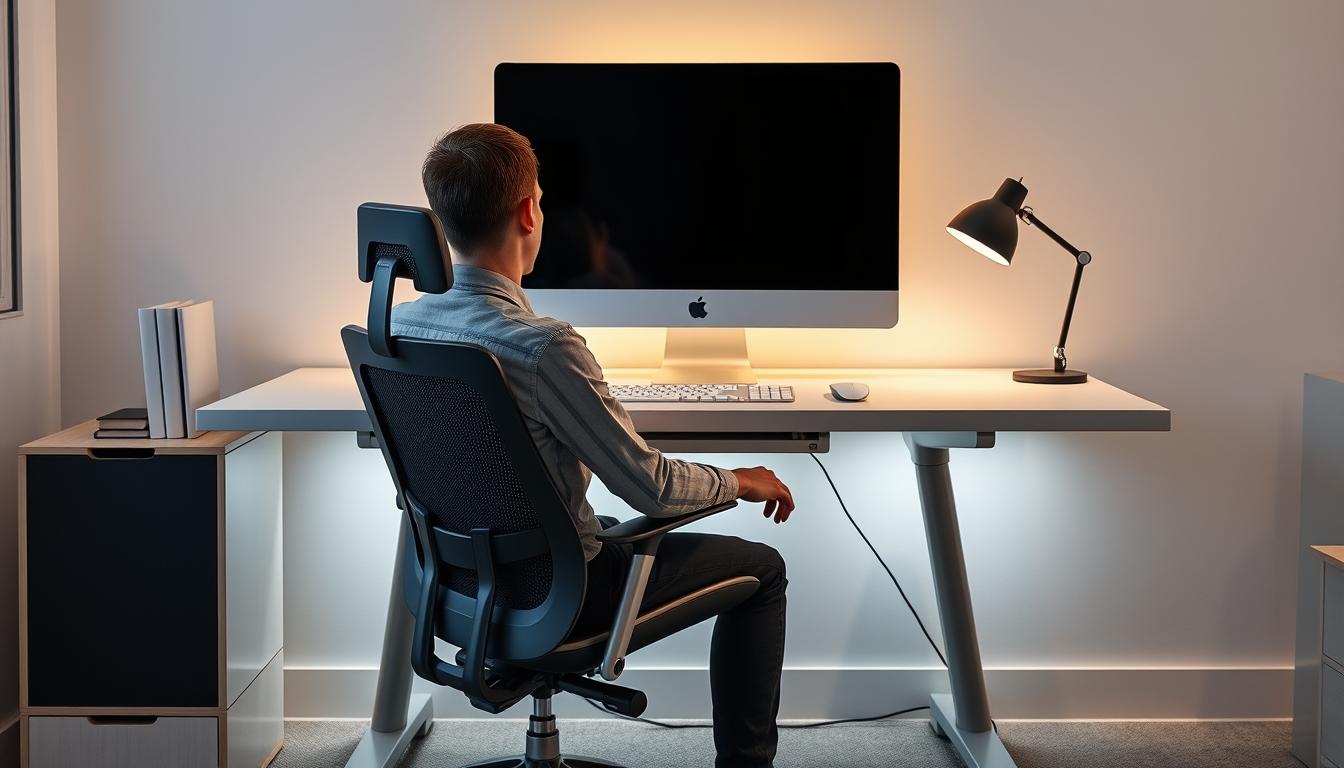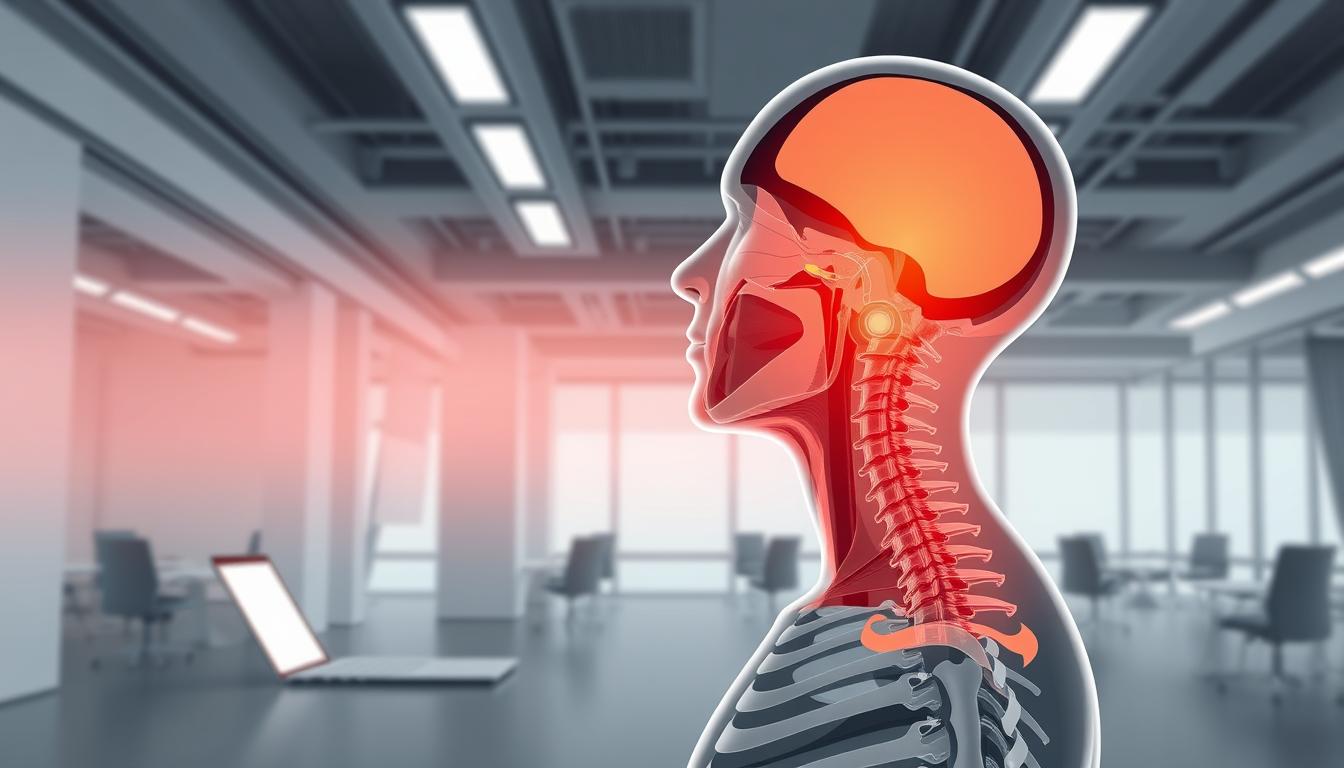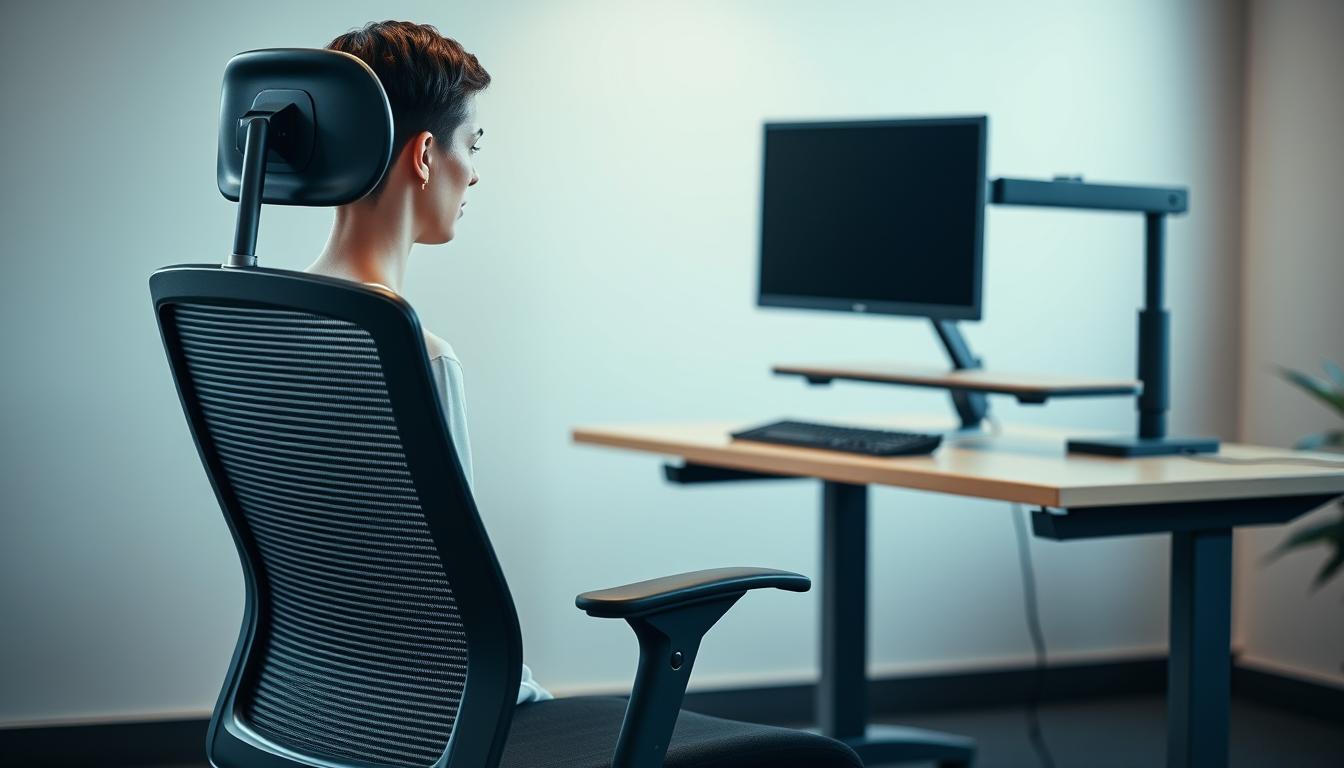Nowadays, using laptops the right way is very important. With more people working from home, it’s vital to have a good workspace. This keeps you productive and healthy. Learning how to sit properly can prevent pain and health problems from bad posture.
This guide will show you how to make your seating and desk help you. You’ll be comfortable and work better. Let’s make your home office a great place to work.
The Importance of Good Posture While Working at Home
Having good posture while working from home is crucial for your health and work output. It’s not just about looking good; it also lowers the chance of musculoskeletal problems. Bad posture can cause discomfort, pinch nerves, and even lead to heart disease and diabetes.
Being aware of your posture can change how you feel every day. With the right posture, you’ll feel better and work better too. Those who focus on their posture often feel less bodily strain, making work feel easier.
Building healthy work-from-home habits offers lasting perks. Keeping good posture during long workdays improves your health and focus. Good posture brings immediate and long-term rewards, leading to a healthier and more efficient work life.
Choosing the Right Chair for Laptop Use
Getting the right chair is key for a comfy and productive workspace. A chair that fits your body helps avoid discomfort during long sitting periods. Make sure it supports your back well to keep your spine straight and healthy.
Support Your Spine
An ergonomic chair with good lumbar support keeps your lower back’s natural curve right. It helps you avoid pain and stand or sit up straight. Get a chair where you can adjust the back support to fit you perfectly.
Adjustable Features Matter
Finding a chair that can change to fit different bodies is important. Being able to adjust the seat and armrests makes your chair fit you better. Your legs should be flat on the ground and your arms relaxed for easy laptop use. A chair with many adjustments will make sitting much more comfortable.
Desk Height and Setup for Comfort
The height of your desk greatly affects how comfy you feel and your posture while you work. Making sure your desk has enough room for your legs is key for good desk ergonomics. It allows you to sit easily, helps blood flow, and makes you less tired.
If you can’t change the height of your desk, try using blocks or a footrest. Adjusting your desk height can lead to a more comfy work area. You can stay in a good posture all day. Make sure things you use a lot are close by. This cuts down on arm and back stress and keeps you sitting right.
Best Practices for Sitting With a Laptop at Home
Making your workspace comfy is key to staying focused and productive. With laptops, it’s crucial to sit right to feel good and avoid health problems. Start by giving your legs enough space and making sure your desk is tidy for easy use.
Ensure Proper Leg Room
Never squeeze your legs under the desk. Make sure there’s enough space. Your feet should be flat on the ground or on a footrest. This helps reduce back strain and supports a good posture. It keeps your spine aligned right, following important sitting tips.
Optimize Desk Space
How you arrange your desk matters a lot for sitting correctly. Keep your workspace neat so you can reach things easily without stretching or twisting. Have everything you use often within easy reach. Less mess means a better stance and a nicer work vibe.
Using Monitors and Laptop Stands
Using the right monitors and laptop stands can make your setup more comfy. A good screen setup helps stop eye strain and makes working feel better. Your screen should be at or just below eye level to keep your neck happy.
Eye Level Alignment
Make sure the top of your screen is at your eye level. This helps avoid neck pain and keeps your body aligned. Having your screen at the right eye level is key for being comfy when you use it a lot.
Distance from Eyes
It’s also key to keep your screen the right distance from your eyes. Keep it about 20 to 40 inches away from your face. This helps you avoid straining your eyes and needing to squint or lean in. Doing this helps prevent eye strain and boosts your efficiency.
Proper Keyboard and Mouse Placement
Getting your keyboard setup right is key for wrist health and comfort at work. Make sure your forearms are parallel to the floor and your wrists are straight. This helps avoid strain from typing for too long.
Position for Wrist Health
Your keyboard should be at a height that’s good for your wrists. Your elbows need to be at a 90-degree angle, or a bit more open. This stops your wrists from bending when you type.
A keyboard that’s too high or too low can cause bad angles. This increases the risk of injuries from repeating the same movements.
Utilizing an Ergonomic Mouse
An ergonomic mouse is important for wrist health. It helps you keep a natural hand position, cutting down on strain. Adding an ergonomic mouse to your setup boosts comfort. It also lowers the risk of injuries like carpal tunnel syndrome.
The Role of Foot Placement in Sitting Posture
Putting your feet right is key to good sitting posture. When your feet are flat or on a footrest, it eases your lower back. It also keeps your knees and hips lined up right. Knowing how feet position matters can make sitting comfy and keep you healthy.
Keeping Feet Flat
Having your feet flat on the floor or a footrest is vital for a good sitting position. This balance lessens spine pressure. If your chair is too tall, your feet can’t reach the floor. Then, it’s time to look at your sitting setup to better your posture.
Using Footrests
Footrests do more than just support. They let you change where you put your feet, helping blood flow and lowering tiredness. Pick a footrest that you can adjust in height and tilt for more comfort when sitting long. Doing this improves your seating and makes your work spot better for your health.
Implementing the 20/20/20 Rule
It’s very important to take care of your eyes when you work a lot in front of a computer screen. The 20/20/20 rule is a great way to keep your eyes healthy. It means every 20 minutes, you should look at something 20 feet away for at least 20 seconds. This simple step can really help reduce eye strain and make working more comfortable.
Protecting Your Eyes
Using the 20/20/20 rule is key for keeping your eyes safe during long hours on the computer. Looking at faraway things helps your eye muscles relax and stops them from getting tired. This not only helps keep your eyes healthy but also makes you more productive, as you can see better and focus more all day.
Reducing Eye Strain
The 20/20/20 rule is important for lessening eye strain. It reminds you to take short breaks from staring at your screen, giving your eyes a well-needed rest. Adding this rule to your daily life creates a healthier work setting. It helps keep your eyes in good shape even with today’s demanding tasks.

Taking Breaks: The Key to Staying Healthy
Taking breaks during work is super important, especially if you sit at a computer all day. Taking short breaks often is good for your health and helps you work better. When planning your day, it’s key to make time for little pauses. These help you focus better and feel more comfortable.
Stretching and Moving
Adding stretches to your day has a lot of pluses. Stretching can ease tension, make blood flow better, and boost your energy. Try to stand and stretch every hour. Moving around during your day helps you stay healthy at work and lowers the chance of getting hurt from doing the same movements too much.
Recommended Break Intervals
Taking a 10-minute break every hour you’re sitting is a smart plan. This time lets you move and do some light exercise. Use this time to get up, take a short walk, or stretch. Having regular breaks scheduled into your day leads to healthier work habits.
Additional Ergonomic Accessories
Adding ergonomic accessories to your workspace boosts comfort and work performance. Items like a document holder and wrist support set up the perfect working space on your laptop. They encourage good posture and lessen discomfort risks when used for a long time.
Document Stands
A document holder keeps your setup ergonomic. It puts documents at eye level, reducing neck strain and keeping you properly aligned. Such a simple change can greatly improve your experience during long sessions of reading or writing.
Wrist Rests
Wrist support is crucial but often forgotten. A good wrist rest eases pain and helps avoid injuries from long periods of typing. It makes using a keyboard or mouse more comfortable, leading to more productive work.
Common Mistakes to Avoid When Sitting with a Laptop
Many people who work from home with laptops fall into bad sitting habits. These habits can cause discomfort and even long-term health problems. Knowing these common mistakes helps us improve our work space and health.
Hunching Over
Hunching over your laptop is a common problem. It can lead to neck and back pain as well as make you tired. Keeping a straight back and having the screen at eye level helps prevent this.
Investing in stands or external monitors is a smart move. They help in maintaining good posture and support.
Staying Seated for Too Long
Sitting too long can harm your health. It may cause stiffness, discomfort, and increase the chance of injuries. Adding short breaks into your schedule helps.
Stand up, stretch, or take a walk every hour. Doing so loosens tension and keeps blood flowing. Moving often is essential to avoid the pitfalls of sitting too long.
Tips for Creating an Ergonomic Home Workspace
Creating an ergonomic home workspace requires thinking about your area’s effects on work and comfort. By applying ergonomic tips, you’ll greatly improve your work life. Whether for productivity or posture, adjusting your home office makes a big difference.
Customizing Your Workspace
Make sure your desk and chair heights match your personal needs. This step is key for good posture during work. Place your monitor at eye level and your keyboard within easy reach to avoid stress. Adding plants or quotes to your space boosts your mood.
Using Household Items as Support
You can use household items for DIY ergonomic fixes. Cushions or towels can support your back. If you lack a stand, books can lift your monitor to the right height. This creativity improves both comfort and functionality in your workspace.
Conclusion
Using the best methods for sitting with a laptop at home is key for better comfort, posture, and health. By applying ergonomic tips, you can make your workspace better and avoid the downsides of bad posture. Small changes, like picking the right chair and where to put your monitor, are really helpful.
Also, using your laptop better means paying attention to how you sit and using things that help support you. Making simple tweaks can make you feel better and work better, setting you up for long-term health. It’s important to focus on ergonomics in your space to live healthier and be more productive every day.



